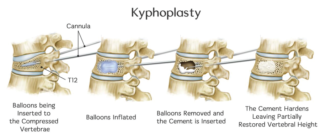
Georgetown Pain Management
Office - 7500 Greenway Center Drive
Suite #940
Greenbelt, MD 20770
Georgetown Pain Management
Surgery Center - 7300 Hanover Drive
Suite #204
Greenbelt, MD 20770
Georgetown Pain Management
2021 K Street, NW
Suite 605
Washington, DC 20037

More Pain Management & Rehabilitation Articles
Kyphoplasty: Treatment For Spinal Compression Fractures

In the United States this year, 700,000 people and one out of every four post-menopausal women will suffer from a painful bone injury called a vertebral compression fracture. This common type of bone injury results in the collapse of a vertebra, a type of bone that makes up the spine. Although there is a safe, effective, and minimally invasive therapy available, two-thirds of these fractures fail to be diagnosed. This is unfortunate, as missing this condition can result in under-treated pain, limitations on daily activities, breathing problems, and dependence on dangerous pain medications.
Bone density in both women and men starts to decrease after age forty, but the loss of density greatly accelerates after women enter menopause and can progress to osteoporosis, a disease characterized by very low bone density, Although most compression fractures occur in patients with osteoporosis, one-third of vertebral compression fractures occur in patients without osteoporosis.
If a fracture occurs suddenly, patients can experience sudden severe back pain that often wraps around the sides and is felt in the chest. Because of this, it is sometimes confused with diseases of the heart or the lungs. The pain is often worse when standing, sitting-up, or walking around. If very severe, the patient can have trouble breathing.
Patients who have symptoms of a fracture should see their doctor for evaluation. After a examination that suggests a vertebral compression fracture, they will often be sent for an MRI. This imaging shows the level of the fracture and also reveals whether it is old or new. Some doctors treat compression fractures with pain medicine, physical therapy, and bracing. However, many cases continue to cause severe pain and long-lasting health effects unless treated more definitively. Unfortunately, many patients and physicians are not aware that there is a minimally invasive procedure called kyphoplasty that can quickly, safely, and effectively treat a patient’s pain without the long-term use of opioids and other pain medications.
If an acute compression fracture is present on an MRI, a patient should be referred to a pain management physician or another physician who performs kyphoplasty. This procedure can often be performed in a doctor’s office, preventing the need for an overnight stay in a hospital. On the day of the procedure, the patient is given a medicine to relax and then is asked to lie on their belly. An x-ray machine is then used to locate the fractured bone and a narrow tube is placed into it through a very small opening in the skin. A small balloon is inflated within the bone to create a small space and the fracture is then filled with bone cement. The entire procedure can take as little as 45 minutes. Many patients feel immediate pain relief and are able to return to their daily lives the day after the procedure. However, some patients may take a week or longer to feel better.
Kyphoplasty most successfully reduces a patient’s pain within two weeks following a fracture. Unfortunately, if the window of opportunity is passed, the pain can become more challenging to treat and further complications can occur.
If you think you or someone you care about is experiencing symptoms of a vertebral compression fracture, be reassured that there are safe, effective, and minimally invasive therapies available. Schedule an initial pain evaluation at Georgetown Pain Management to determine if you’re eligible for kyphoplasty or other pain therapies. Most insurances are accepted and new patient evaluations are currently being scheduled. As awareness of this condition increases and more patients are offered kyphoplasty as a minimally-invasive therapy, it is hopeful that fewer patients will have to live with the severe pain that results from vertebral compression fractures and can return to their full lives more quickly and comfortably than before.
Other Articles You May Find of Interest...
- The Secrets Behind Knee Noises: When to Seek Help
- Is Custom Bracing the Secret Weapon for Your Chronic Pain Battle?
- Is Your Pain Trying to Tell You Something? Decode and Manage Your Body’s Signals
- The Benefits of Spinal Cord Stimulation in Treating Chronic Pain
- Why Choose an Orthopaedic Specialist for Spine Treatment?
- Understanding the Impact of Aging on Your Spine
- Free Yourself From Heartburn Pain

















